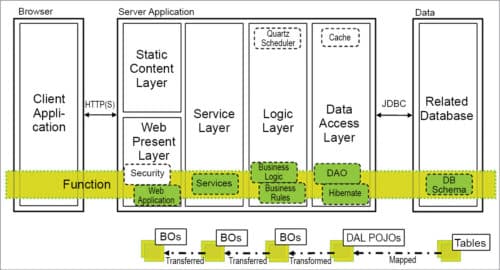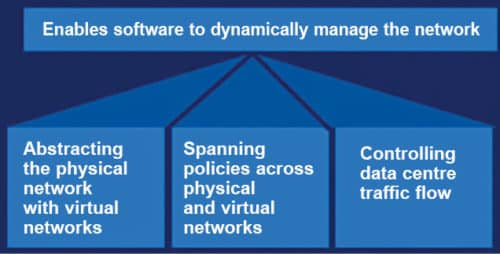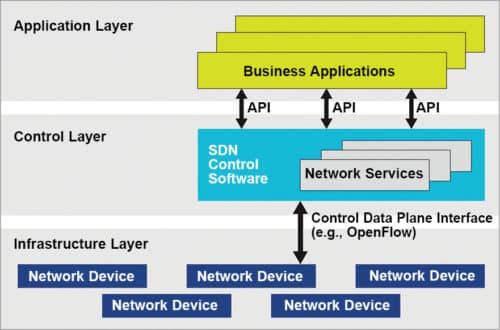SaaS refers to business software applications delivered via the cloud. As industries embrace new technologies and innovate to improve operations and solve customer problems, the move to a software-centric model will drive digital transformation.
Software as a Service (SaaS) is a software service model in which the service provider hosts applications over the Internet to make these available to customers. It is the topmost layer of the cloud computing system, which has Platform as a Service (PaaS) and Infrastructure as a Service (IaaS) as the other two layers.
SaaS eliminates the expense of provisioning and maintenance, hardware acquisition, software licensing, installation and support for organisations. It also removes the need to install and run applications on their own computers or data centres.
SaaS is closely related to software delivery models like on-demand computing and application service providers. It allows users to use cloud-based apps such as email, calendar and office tools like Microsoft Office 365, Google apps, Salesforce, Citrix GoToMeeting and Cisco WebEx, among others.
SaaS enables device manufacturers to create value from software-enabled devices. This service-based licensing model can give a new lease of life to hardware applications all over the globe and facilitate flexible business models. SaaS can be used by enterprises for accounting and invoicing, tracking sales, planning, performance monitoring, communications and more, in a number of industries.
How it works
The service provider hosts the customer’s software and firmware over the Internet, by creating an application for SaaS distribution, and gives network-based access to registered customers. Whenever new features are implemented, these are updated for customers’ access. During this process, customers’ model data may be stored locally or in the cloud, as per the service level agreement (SLA).
SaaS applications can be integrated with other software using application programming interfaces (APIs). For example, a business can integrate SaaS provider APIs with its own written software tools.
Why go for the software-based approach
Before SaaS was available, companies had to purchase compact disks containing updates for software on their computers. For large organisations, updating software was a time-consuming process. Later, software updates became available for download on the Internet. This led companies to purchase additional licences and required a copy of the software to be installed on all devices.
SaaS is a Web-based model, in which the software vendor hosts and maintains servers, databases and codes that constitute an application. On-premise software is purchased through a perpetual licence, for which pay-per-year maintenance and support fees is needed. Whereas, SaaS has an annual or monthly subscription fee, which includes the software licence with support and most other fees.
SaaS is easy to implement, update and debug, and is less expensive. Users pay only for SaaS as-they-go, instead of purchasing multiple software licences for multiple computers. It has various uses including managing transactions, tracking leads, scheduling events, auditing and so on.
According to Sameer Redij, chief revenue officer and managing partner, EvolutionCo Digital & Interactive Consultancy, “Digital technologies are disrupting the way traditional business models operate. Customers are demanding transformational experiences that will redefine their organisation and its relationship with its ecosystem (clients, partners, employees, etc). Whether it is improving employee productivity or building customer experiences, more and more organisations are relying on the Web and a mobile-based ecosystem. Software solutions are now redefining businesses and processes. There are ample business cases like online marketplaces that have been innovative and transformational.”
Web-based solutions for businesses
SaaS applications for fundamental business technologies are email management, sales management, customer relationship management (CRM), financial management, human resource management, billing and collaboration, among others. Leading SaaS providers include Oracle, Salesforce, SAP, Microsoft, Intuit and many others.
SaaS offers pay-as-you-go services where one needs to pay the amount only for the time of use of an app or by subscription chosen. All underlying infrastructure, app software, app data and middleware are located on the service provider’s data centre. The service provider manages the hardware and software.
An appropriate service agreement ensures availability and security of the app and data. One can access emails and stored messages from a Web browser on any computer or Internet-connected device.

Examples of software-centric business models
Uber is a classic example of a software-centric business model. There are similar examples of cloud-based service providers like Amazon and Zomato, which are breaking traditional boundaries and creating new business avenues. The emphasis of these businesses is on finding opportunities and problems, and providing digital solutions that address these in an experiential manner.
EvolutionCo is a digital transformation and consulting-approach-based organisation. It provides custom software solutions (business applications) to clients across the business spectrum, right from human resource, finance, sales and marketing to operations, CRMs, project management software, and a suite of different portal and mobile-based solutions.
Advantages of SaaS
There is no hardware cost involved, as processing power is supplied by the cloud provider. Applications are ready to use once the user subscribes, with no initial setup costs. There is no need to install new software and hardware to access additional storage or on-demand services.
Updates are often deployed automatically by the software provider. Applications can be altered to suit individual needs. Users can run most SaaS apps directly from their Web browser. SaaS makes even sophisticated enterprise applications, such as ERP and CRM, affordable for organisations that lack the resources like infrastructure and software.
SaaS makes it easy to mobilise the workforce because users can access SaaS apps and data from any Internet-connected computer or mobile device. No data is lost if a user’s computer or device fails, as app data is stored in the cloud. Security of data is ensured by the service provider regardless of the type of device consuming it.
SaaS offers high scalability. It gives access of services to customers on demand. The SaaS provider automatically performs updates and patch management for all software applications.
Security in SaaS model
When someone on the outside maintains an organisation’s critical data, security is crucial. Data security is independent of the location of the server or the user. To ensure security, it is important for a data centre to undergo stringent security procedures of SAS70 type II audits.
SLAs set system reliability standards and parameters for issues such as data ownership, security requirements and maintenance. Users should ensure the clause in SLAs regarding the state of ownership of data.
Most SaaS contracts provide access to data and back it up locally as needed. However, contracts should also include type of format and availability for data, in addition to its migration for an appropriate fee.
Software-based solution for devices
Javier Barabas, IBM cloud and cognitive technical leader, says, “As far as software-centric technologies for devices are concerned, all IoT technologies will fit in this space.”
Redij adds, “Innovative software solutions for devices based on the IoT, augmented and virtual reality, and voice-based devices like Amazon Echo Dot and Google Home create new experiences and solutions for clients’ unique business needs.”
Since data is stored on external servers, companies need to be sure that it is safe and cannot be accessed by unauthorised parties. There should be a high-speed Internet connection as slow connections can hamper performance.
Some vendors have developed offline functionality to allow people to keep working even if the Internet goes down. All data is synced to the system once a good connection is available again. In SaaS, businesses rely on outside vendors for software and its updates, and facilitate a secure environment for their business data. They should understand their SaaS provider’s SLA and make sure it is enforced.

Software-defined networking
Software-defined networking (SDN) defines how a networking and computing system can be built using a combination of open, software-based technologies and commodity networking hardware. It enables engineers and administrators of the cloud computing network to respond quickly to changing business requirements via a centralised control console.
SDN encompasses multiple kinds of network technology designs. This makes the network more flexible and agile to support the virtualised server and storage infrastructure of the modern data centre. SDN is an approach to design, build and manage a network that separates its control or SDN policy (brains) and forwarding (muscle) planes. This enables network control to become directly programmable and underlying infrastructure to be abstracted for applications and network services for applications such as SDN cloud computing or mobile networks.
The goal of SDN is to improve network control to enable enterprises and service providers to respond quickly. It is an emerging architecture that is dynamic, cost-effective, manageable and adaptable. It is ideal for the high-bandwidth and dynamic nature of today’s applications.

The foundational element for building SDN solutions is OpenFlow protocol. A network engineer can shape traffic from a centralised control console in SDN without working on individual switches in the network.
Software-defined wide-area network (SD-WAN) is an extension of SDN. This technology allows an enterprise to connect all their networks within their system across a wide geographic area. For example, all data centres and branch office networks within an enterprise are connected via SD-WAN. Its ability to unify various connections are turning organisations and companies towards SD-WAN.
Another benefit of SD-WAN is end-to-end encryption across the network, which increases security.
SDN architecture to support SaaS
SDN removes the need to purchase application-specific integrated circuit (ASIC)-based networking hardware, and supports pay-as-you-go models. This reduces operational expenses.
SDN enables algorithmic control of the network of programmable elements. This makes it easier to design, deploy, manage and scale networks. The ability to automate optimises service availability and reliability by reducing overall management time and chance for human error.
SDN helps organisations deploy new applications, services and infrastructure to quickly meet changing business goals and objectives. It enables them to implement new business models that can offer new revenue streams and more value from the network.
SDN has the potential to revolutionise legacy data centres by providing a flexible way to control the network. It provides different services to different organisations. For cloud computing and data centres, network virtualisation offers better utilisation of resources and faster turnaround times for creating a segregated network.
Conclusion
SaaS refers to business software applications delivered via the cloud. Given the widespread cloud accessibility, it is easier, faster and less expensive to roll out applications. Today, nearly every type of core business function is available via SaaS.
SDN enables the programming of network behaviour in a centrally-controlled manner using open APIs. By implementing SDN control layer, operators can manage the entire network and its devices consistently, regardless of the complexity of the underlying network technology.
The shift to a software-centric model is disrupting traditional industrial markets and companies. Many manufacturers are starting on a path to fundamentally transform their business models and cultures by forging digital connections with suppliers, customers and other manufacturers, and by creating digital-based products and services that deliver business outcomes. As industries embrace new technologies and innovate to improve operations and solve customer problems, the move to a software-centric model will drive digital transformation.






